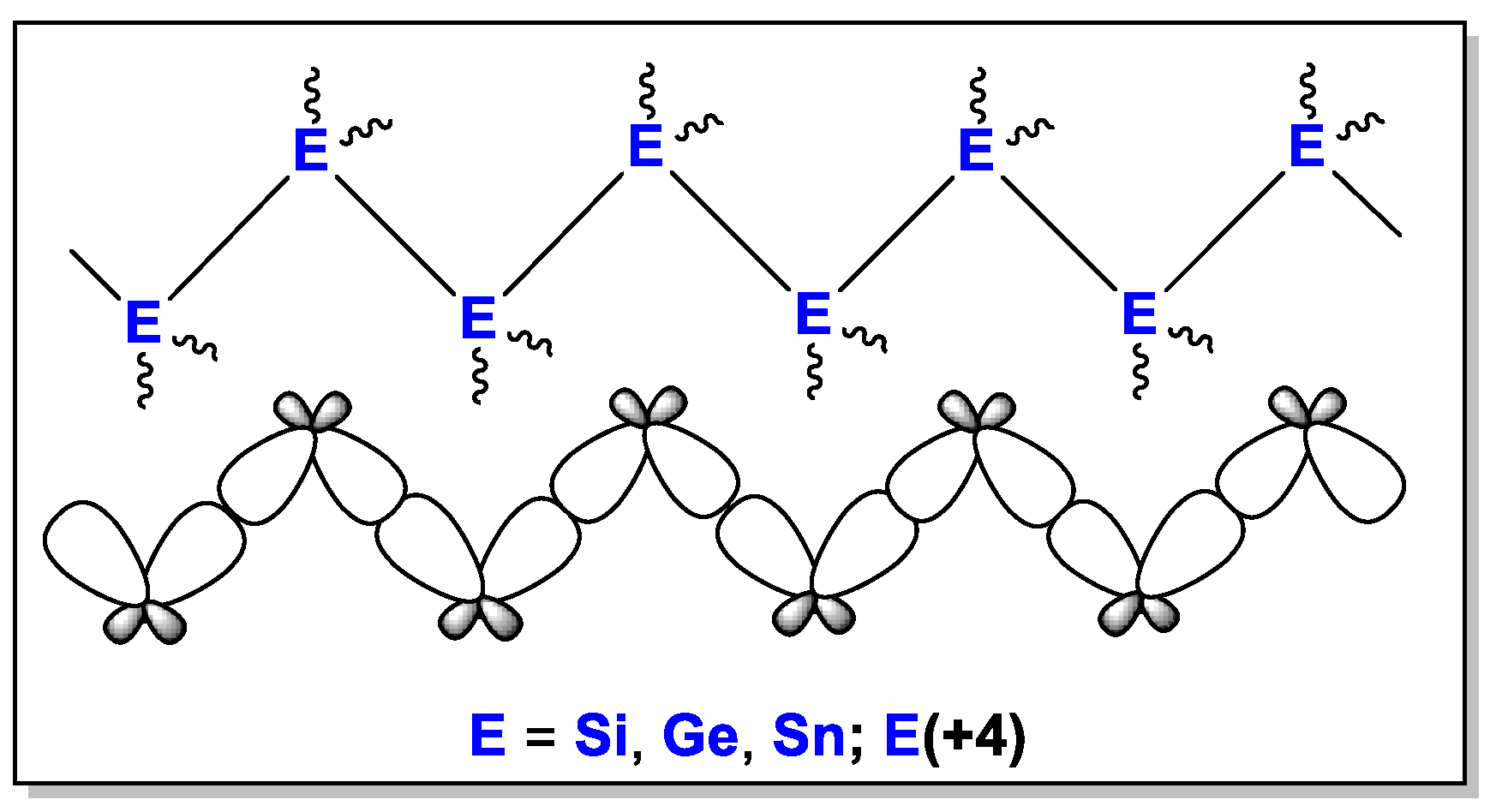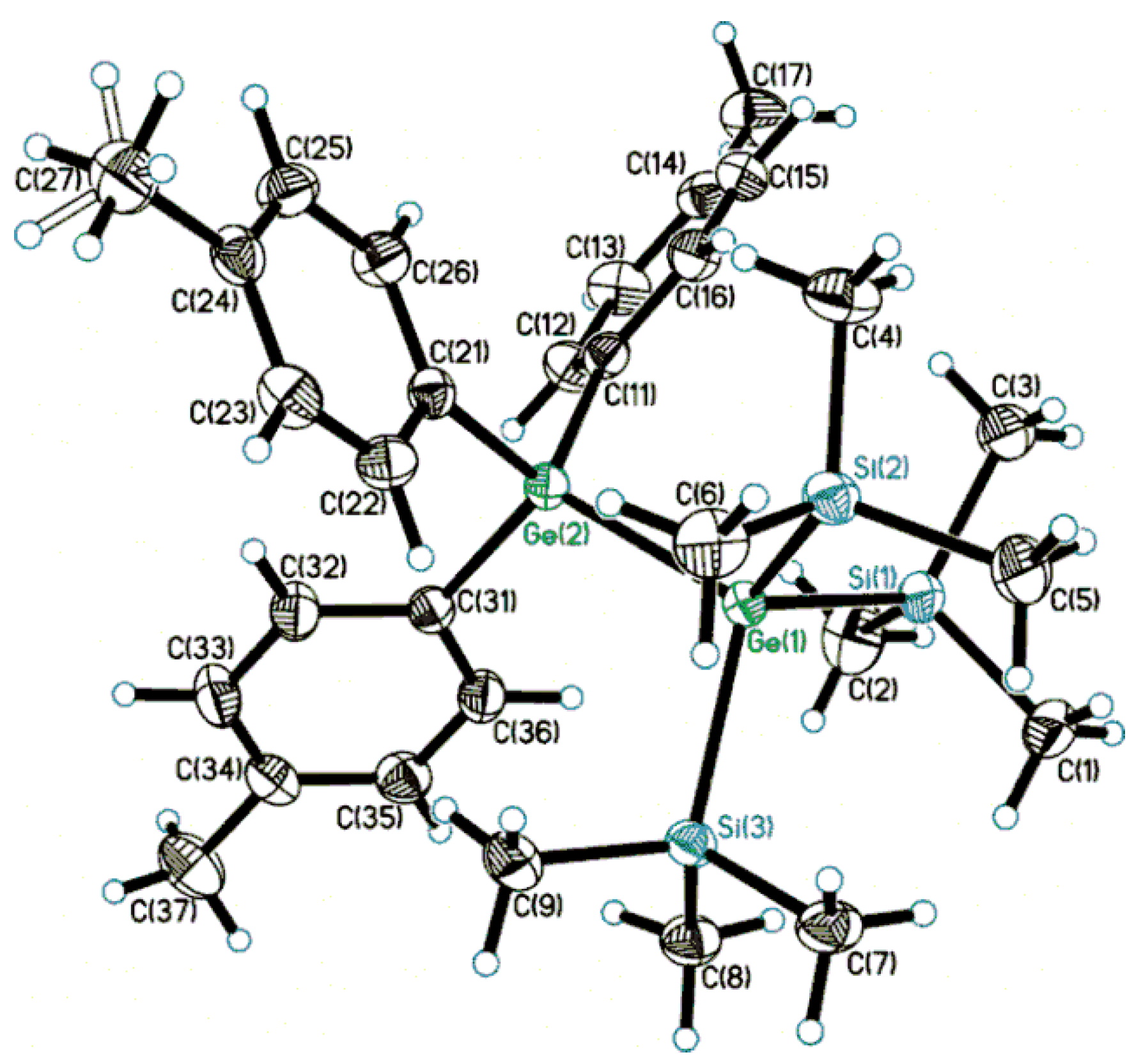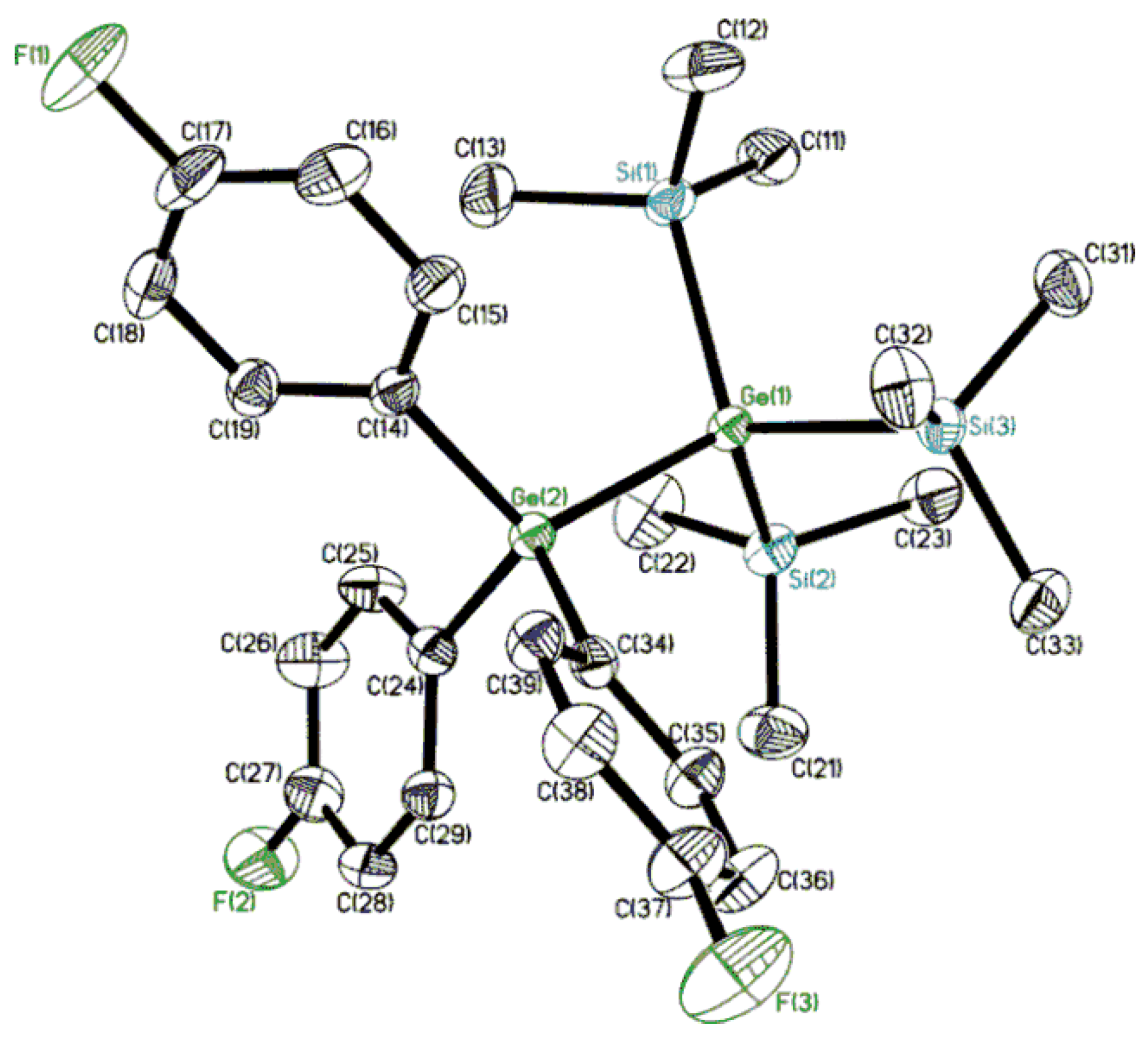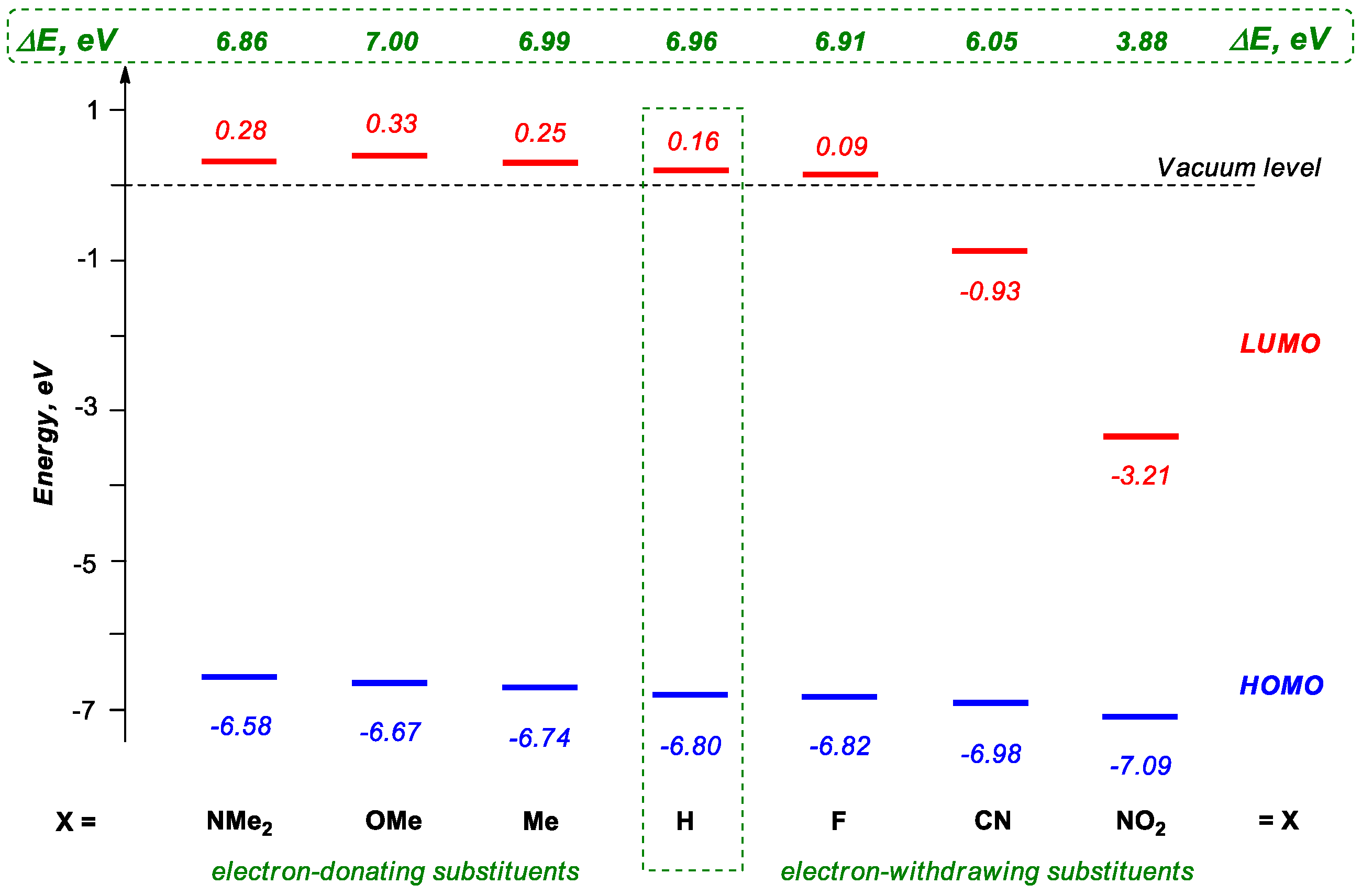Oligoorganogermanes: Interplay between Aryl and Trimethylsilyl Substituents
Abstract
:1. Introduction
2. Results and Discussion
2.1. Synthesis
2.2. NMR Spectroscopy
2.3. XRD Structures
2.4. DFT Calculations
2.5. UV/Vis Absorption
3. Materials and Methods
3.1. Experimental Details
3.2. X-ray Crystallography
3.3. DFT Calculations
3.4. Synthesis
4. Conclusions
Supplementary Materials
Author Contributions
Funding
Institutional Review Board Statement
Informed Consent Statement
Data Availability Statement
Acknowledgments
Conflicts of Interest
Sample Availability
References
- Kunkel, C.; Bolte, M.; Lerner, H.-W.; Albert, P.; Wagner, M. Subvalent mixed SixGey oligomers: (Cl3Si)4Ge and Cl2(Me2EtN)SiGe(SiCl3)2. Chem. Commun. 2021, 57, 12028–12031. [Google Scholar] [CrossRef] [PubMed]
- Binder, M.; Schrenk, C.; Block, T.; Pöttgen, R.; Schnepf, A. LiGe(SiMe3)3: A New Substituent for the Synthesis of Metalloid Tin Clusters from Metastable Sn(I) Halide Solutions. Molecules 2018, 23, 1022. [Google Scholar] [CrossRef] [Green Version]
- Rivard, E. Group 14 inorganic hydrocarbon analogues. Chem. Soc. Rev. 2016, 45, 989–1003. [Google Scholar] [CrossRef] [PubMed]
- Steller, B.G.; Doler, B.; Fischer, R.C. Diaryltin Dihydrides and Aryltin Trihydrides with Intriguing Stability. Molecules 2020, 25, 1076. [Google Scholar] [CrossRef] [PubMed] [Green Version]
- Miller, R.D.; Michl, J. Polysilane high polymers. Chem. Rev. 1989, 89, 1359–1410. [Google Scholar] [CrossRef]
- Amadoruge, M.L.; Weinert, C.S. Singly Bonded Catenated Germanes: Eighty Years of Progress. Chem. Rev. 2008, 108, 4253–4294. [Google Scholar] [CrossRef] [PubMed]
- Sita, L.R. Structure/Property Relationships of Polystannanes. In Advances in Organometallic Chemistry; Stone, F.G.A., West, R., Eds.; Academic Press: San Diego, CA, USA, 1995; Volume 38, pp. 189–243. [Google Scholar]
- Wang, Y.; Quillian, B.; Wei, P.; Yang, X.-J.; Robinson, G.H. New Pb–Pb bonds: Syntheses and molecular structures of hexabiphenyldiplumbane and tri(trisbiphenylplumbyl)plumbate. Chem. Commun. 2004, 19, 2224–2225. [Google Scholar] [CrossRef] [PubMed]
- Marschner, C.; Hlina, J. 1.03—Catenated Compounds—Group 14 (Ge, Sn, Pb). In Comprehensive Inorganic Chemistry II, 2nd ed.; Reedijk, J., Poeppelmeier, K., Eds.; Elsevier: Amsterdam, The Netherlands, 2013; pp. 83–117. [Google Scholar]
- Jovanovic, M.; Michl, J. Alkanes versus Oligosilanes: Conformational Effects on σ-Electron Delocalization. J. Am. Chem. Soc. 2022, 144, 463–477. [Google Scholar] [CrossRef]
- Léal, M.A.; Begic, K.; Campbell, J.; Kirkman, N.; Myers, D.; Schrick, A.C.; Rheingold, A.L.; Weinert, C.S. Preparation, absorption spectra, and electrochemsitry of the trigermanes R3GeGePh2GeR3 (R3 = tBuMe2, PhMe2, nBu3) and tetragermanes R3Ge(GePh2)2GeR3 (R3 = Et3, nBu3). J. Organomet. Chem. 2020, 925, 121467. [Google Scholar] [CrossRef]
- Foucher, D. Catenated Germanium and Tin Oligomers and Polymers. In Main Group Strategies towards Functional Hybrid Materials; Baumgartner, T., Jäkle, F., Eds.; John Wiley & Sons Ltd.: Chichester, UK, 2018; Chapter 9; pp. 209–236. [Google Scholar]
- Yu, H.; Ni, C.; Thiessen, A.N.; Li, Z.; Veinot, J.G.C. Synthesis, Properties, and Derivatization of Poly(dihydrogermane): A Germanium-Based Polyethylene Analogue. ACS Nano 2021, 15, 9368–9378. [Google Scholar] [CrossRef]
- Klausen, R.S.; Ballestero-Martínez, E. Organosilicon and Related Group 14 Polymers. In Reference Module in Chemistry, Molecular Sciences and Chemical Engineering; Elsevier: Oxford, UK, 2021. [Google Scholar] [CrossRef]
- Su, T.A.; Li, H.; Klausen, R.S.; Kim, N.T.; Neupane, M.; Leighton, J.L.; Steigerwald, M.L.; Venkataraman, L.; Nuckolls, C. Silane and Germane Molecular Electronics. Acc. Chem. Res. 2017, 50, 1088–1095. [Google Scholar] [CrossRef] [PubMed]
- Zaitsev, K.V.; Tafeenko, V.A.; Oprunenko, Y.F.; Kharcheva, A.V.; Zhanabil, Z.; Suleimen, Y.; Lam, K.; Zaitsev, V.B.; Zaitseva, A.V.; Zaitseva, G.S.; et al. Molecular Oligogermanes and Related Compounds: Structure, Optical and Semiconductor Properties. Chem. Asian J. 2017, 12, 1240–1249. [Google Scholar] [CrossRef] [PubMed] [Green Version]
- Selmani, A.; Schoenebeck, F. Transition-Metal-Free, Formal C–H Germylation of Arenes and Styrenes via Dibenzothiophenium Salts. Org. Lett. 2021, 23, 4779–4784. [Google Scholar] [CrossRef] [PubMed]
- Yu, X.; Lübbesmeyer, M.; Studer, A. Oligosilanes as Silyl Radical Precursors through Oxidative Si−Si Bond Cleavage Using Redox Catalysis. Angew. Chem. Int. Ed. 2021, 60, 675–679. [Google Scholar] [CrossRef] [PubMed]
- Samanamu, C.R.; Amadoruge, M.L.; Yoder, C.H.; Golen, J.A.; Moore, C.E.; Rheingold, A.L.; Materer, N.F.; Weinert, C.S. Syntheses, Structures, and Electronic Properties of the Branched Oligogermanes (Ph3Ge)3GeH and (Ph3Ge)3GeX (X = Cl, Br, I). Organometallics 2011, 30, 1046–1058. [Google Scholar] [CrossRef]
- Schrick, E.K.; Forget, T.J.; Roewe, K.D.; Schrick, A.C.; Moore, C.E.; Golen, J.A.; Rheingold, A.L.; Materer, N.F.; Weinert, C.S. Substituent Effects in Digermanes: Electrochemical, Theoretical, and Structural Investigations. Organometallics 2013, 32, 2245–2256. [Google Scholar] [CrossRef]
- Zaitsev, K.V.; Kapranov, A.A.; Churakov, A.V.; Poleshchuk, O.K.; Oprunenko, Y.F.; Tarasevich, B.N.; Zaitseva, G.S.; Karlov, S.S. “Donor–Acceptor” Oligogermanes: Synthesis, Structure, and Electronic Properties. Organometallics 2013, 32, 6500–6510. [Google Scholar] [CrossRef]
- Baumgartner, J.; Fischer, R.; Fischer, J.; Wallner, A.; Marschner, C.; Flörke, U. Structural Aspects of Trimethylsilylated Branched Group 14 Compounds. Organometallics 2005, 24, 6450–6457. [Google Scholar] [CrossRef]
- Hlina, J.; Zitz, R.; Wagner, H.; Stella, F.; Baumgartner, J.; Marschner, C. σ-Bond electron delocalization of branched oligogermanes and germanium containing oligosilanes. Inorg. Chim. Acta 2014, 422, 120–133. [Google Scholar] [CrossRef] [Green Version]
- Wagner, H.; Baumgartner, J.; Müller, T.; Marschner, C. Shuttling Germanium Atoms into Branched Polysilanes. J. Am. Chem. Soc. 2009, 131, 5022–5023. [Google Scholar] [CrossRef]
- Marschner, C.; Baumgartner, J.; Wallner, A. Structurally and conformationally defined small methyl polysilanes. Dalton Trans. 2006, 48, 5667–5674. [Google Scholar] [CrossRef] [PubMed]
- Mallela, S.P.; Geanangel, R.A. Preparation and structural characterization of new derivatives of digermane bearing tris(trimethylsilyl)silyl substituents. Inorg. Chem. 1991, 30, 1480–1482. [Google Scholar] [CrossRef]
- Zaitsev, K.V.; Lermontova, E.K.; Churakov, A.V.; Tafeenko, V.A.; Tarasevich, B.N.; Poleshchuk, O.K.; Kharcheva, A.V.; Magdesieva, T.V.; Nikitin, O.M.; Zaitseva, G.S.; et al. Compounds of Group 14 Elements with an Element–Element (E = Si, Ge, Sn) Bond: Effect of the Nature of the Element Atom. Organometallics 2015, 34, 2765–2774. [Google Scholar] [CrossRef]
- Allen, L.C. Electronegativity is the average one-electron energy of the valence-shell electrons in ground-state free atoms. J. Am. Chem. Soc. 1989, 111, 9003–9014. [Google Scholar] [CrossRef]
- Zaitsev, K.V.; Kharcheva, A.V.; Lam, K.; Zhanabil, Z.; Issabayeva, G.; Oprunenko, Y.F.; Churakov, A.V.; Zaitseva, G.S.; Karlov, S.S. Donor-acceptor molecular oligogermanes: Novel properties and structural aspects. J. Organomet. Chem. 2018, 867, 228–237. [Google Scholar] [CrossRef]
- Fischer, J.; Baumgartner, J.; Marschner, C. Silylgermylpotassium Compounds. Organometallics 2005, 24, 1263–1268. [Google Scholar] [CrossRef]
- Hlina, J.; Baumgartner, J.; Marschner, C. Polygermane Building Blocks. Organometallics 2010, 29, 5289–5295. [Google Scholar] [CrossRef]
- Simon, D.; Häberle, K.; Dräger, M. Über polygermane: XI. Funktionalisierung von hexaphenyldigerman. J. Organomet. Chem. 1984, 267, 133–142. [Google Scholar] [CrossRef]
- Ng, M.C.C.; Craig, D.J.; Harper, J.B.; van Eijck, L.; Stride, J.A. The Central Atom Size Effect on the Structure of Group 14 Tetratolyls. Chem. Eur. J. 2009, 15, 6569–6572. [Google Scholar] [CrossRef]
- Zaitsev, K.V.; Lam, K.; Zhanabil, Z.; Suleimen, Y.; Kharcheva, A.V.; Tafeenko, V.A.; Oprunenko, Y.F.; Poleshchuk, O.K.; Lermontova, E.K.; Churakov, A.V. Oligogermanes Containing Only Electron-Withdrawing Substituents: Synthesis and Properties. Organometallics 2017, 36, 298–309. [Google Scholar] [CrossRef]
- Kurzbach, D.; Yao, S.; Hinderberger, D.; Klinkhammer, K.W. EPR spectroscopic characterization of persistent germyl-substituted Pb(III)- and Sn(III)-radicals. Dalton Trans. 2010, 39, 6449–6459. [Google Scholar] [CrossRef]
- Katir, N.; Matioszek, D.; Ladeira, S.; Escudié, J.; Castel, A. Stable N-Heterocyclic Carbene Complexes of Hypermetallyl Germanium(II) and Tin(II) Compounds. Angew. Chem. Int. Ed. 2011, 50, 5352–5355. [Google Scholar] [CrossRef] [PubMed]
- Nanjo, M.; Sekiguchi, A. Group-14-element-based hybrid dendrimers. Synthesis and characterization of dendrimers with alternating Si and Ge atoms in the chains. Organometallics 1998, 17, 492–494. [Google Scholar] [CrossRef]
- Yang, L.; Powell, D.R.; Houser, R.P. Structural variation in copper(i) complexes with pyridylmethylamide ligands: Structural analysis with a new four-coordinate geometry index, τ4. Dalton Trans. 2007, 9, 955–964. [Google Scholar] [CrossRef]
- West, R. A new theory for rotational isomeric states: Polysilanes lead the way. J. Organomet. Chem. 2003, 685, 6–8. [Google Scholar] [CrossRef]
- Laske Cooke, J.A.; Rahbarnoohi, H.; McPhail, A.T.; Wells, R.L.; White, P.S. Reactions of phenylaluminium compounds with E(SiMe3)3 (E = P or As): X-ray crystal structures of Ph3Al·E(SiMe3)3 (E = P or As) and Ph2(Cl)Al·P(SiMe3)3. Polyhedron 1996, 15, 3033–3044. [Google Scholar] [CrossRef]
- Mallela, S.P.; Saar, Y.; Hill, S.; Geanangel, R.A. Reactions of LiE(SiMe3)3, E = Si, Ge: X-ray crystal structure of the cyclotetrastannane [ClSnSi(SiMe3)3]4. Inorg. Chem. 1999, 38, 2957–2960. [Google Scholar] [CrossRef]
- Amadoruge, M.L.; Short, E.K.; Moore, C.; Rheingold, A.L.; Weinert, C.S. Structural, spectral, and electrochemical investigations of para-tolyl-substituted oligogermanes. J. Organomet. Chem. 2010, 695, 1813–1823. [Google Scholar] [CrossRef]
- Zaitsev, K.V.; Oprunenko, Y.F.; Churakov, A.V.; Zaitseva, G.S.; Karlov, S.S. Reaction of digermanes and related Ge-Si compounds with trifluoromethanesulfonic acid: Synthesis of helpful building blocks for the preparation of Ge-Ge(Si)-catenated compounds. Main Group Metal Chem. 2014, 37, 67–74. [Google Scholar] [CrossRef]
- Bobbitt, K.L.; Maloney, V.M.; Gaspar, P.P. New photochemical routes to germylenes and germenes and kinetic evidence concerning the germylene-diene addition mechanism. Organometallics 1991, 10, 2772–2777. [Google Scholar] [CrossRef]
- Brook, A.G.; Abdesaken, F.; Söllradl, H. Synthesis of some tris(trimethylsilyl)germyl compounds. J. Organomet. Chem. 1986, 299, 9–13. [Google Scholar] [CrossRef]
- Lee, V.Y.; Yasuda, H.; Ichinohe, M.; Sekiguchi, A. Heavy cyclopropene analogues R4SiGe2 and R4Ge3 (R = SiMetBu2)—New members of the cyclic digermenes family. J. Organomet. Chem. 2007, 692, 10–19. [Google Scholar] [CrossRef]
- Frisch, M.J.; Trucks, G.W.; Schlegel, H.B.; Scuseria, G.E.; Robb, M.A.; Cheeseman, J.R.; Scalmani, G.; Barone, V.; Mennucci, B.; Petersson, G.A.; et al. Gaussian 09, Revision C.01; Gaussian Inc.: Wallingford, UK, 2010. [Google Scholar]
- Zhao, Y.; Truhlar, D.G. The M06 suite of density functionals for main group thermochemistry, thermochemical kinetics, noncovalent interactions, excited states, and transition elements: Two new functionals and systematic testing of four M06-class functionals and 12 other functionals. Theor. Chem. Acc. 2008, 120, 215–241. [Google Scholar]
- Tomasi, J.; Persico, M. Molecular Interactions in Solution: An Overview of Methods Based on Continuous Distributions of the Solvent. Chem. Rev. 1994, 94, 2027–2094. [Google Scholar] [CrossRef]






| Compound | λmax (Calcd.), nm | Oscillator Strength, f | Transition |
|---|---|---|---|
| (Me3Si)3Ge-GePh3 | 228 | 0.35 (0.15) | HOMO–LUMO+1 |
| (Me3Si)3Ge-Ge(C6H4Me-p)3 (1) | 239 | 0.46 (0.11) | HOMO-2–LUMO |
| (Me3Si)3Ge-Ge(C6H4OMe-p)3 | 235 | 0.57 (0.22) | HOMO-2–LUMO |
| (Me3Si)3Ge-Ge(C6H4NMe2-p)3 | 244 | 0.28 (0.58) | HOMO-2–LUMO |
| (Me3Si)3Ge-Ge(C6H4F-p)3 (2) | 233 | 0.28 (0.27) | HOMO-2–LUMO+1 |
| (Me3Si)3Ge-Ge(C6H4CN-p)3 | 261 | 0.42 (0.22) | HOMO-2–LUMO+1 |
| (Me3Si)3Ge-Ge(C6H4NO2-p)3 | 518 | 0.18 (0.01) | HOMO-2–LUMO+2 |
| Compound | λmax, nm (ε × 10−4, M−1 cm−1) | Solvent | Reference |
|---|---|---|---|
| Me3Ge-Ge(C6H4Me-p)3 | 234 (3.7) | CH2Cl2 | [27] |
| (p-MeC6H4)3Ge-Ge(C6H4Me-p)3 | 241 (1.8) | CH2Cl2 | [42] |
| (p-MeC6H4)3Ge-Ge(C6F5)3 | 234 (4.6) | CH2Cl2 | [21] |
| (p-MeC6H4)3Ge-GePh3 | 240 | CH2Cl2 | [42] |
| (Me3Si)3Ge-Ge(SiMe3)3 | 209 (7.8) | n-pentane | [22] |
| (Me3Si)3Ge-GeCl3 | 231 (1.4) | n-hexane | [21] |
| (Me3Si)3Ge-GePh3 | 234 (2.7) | n-hexane | [27] |
| Me3Si-Ge(C6H4Me-p)3 | 230 (3.3) | n-hexane | [27] |
| Me3Si-Ge(C6H4Me-p)3 | 231 (1.8) | CH2Cl2 | [27] |
| (t-Bu)Me2Si-Ge(C6H4Me-p)3 | 233 (3.2) | n-hexane | [43] |
| (t-Bu)Me2Si-Ge(C6H4Me-p)3 | 235 (4.5) | CH2Cl2 | [43] |
| [Me3Si]2-GePh2 | 238 (1.5) | n-pentane | [44] |
| Me3Si-Me2Si-Ge(C6H4Me-p)3 | 241 (2.5) | CH2Cl2 | [16] |
| (Me3Si)3Ge-Ge(C6H4Me-p)3 (1) | 239 (3.1) | n-hexane | this work |
| (Me3Si)3Ge-Ge(C6H4F-p)3 (2) | 230 (3.3) | n-hexane | this work |
| (Me3Si)3Ge-Ge(C6F5)3 (3) | 242 (3.1) | n-hexane | this work |
Publisher’s Note: MDPI stays neutral with regard to jurisdictional claims in published maps and institutional affiliations. |
© 2022 by the authors. Licensee MDPI, Basel, Switzerland. This article is an open access article distributed under the terms and conditions of the Creative Commons Attribution (CC BY) license (https://creativecommons.org/licenses/by/4.0/).
Share and Cite
Zaitsev, K.V.; Poleshchuk, O.K.; Churakov, A.V. Oligoorganogermanes: Interplay between Aryl and Trimethylsilyl Substituents. Molecules 2022, 27, 2147. https://doi.org/10.3390/molecules27072147
Zaitsev KV, Poleshchuk OK, Churakov AV. Oligoorganogermanes: Interplay between Aryl and Trimethylsilyl Substituents. Molecules. 2022; 27(7):2147. https://doi.org/10.3390/molecules27072147
Chicago/Turabian StyleZaitsev, Kirill V., Oleg Kh. Poleshchuk, and Andrei V. Churakov. 2022. "Oligoorganogermanes: Interplay between Aryl and Trimethylsilyl Substituents" Molecules 27, no. 7: 2147. https://doi.org/10.3390/molecules27072147
APA StyleZaitsev, K. V., Poleshchuk, O. K., & Churakov, A. V. (2022). Oligoorganogermanes: Interplay between Aryl and Trimethylsilyl Substituents. Molecules, 27(7), 2147. https://doi.org/10.3390/molecules27072147









